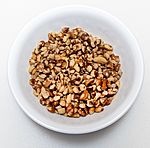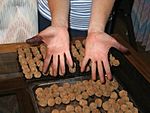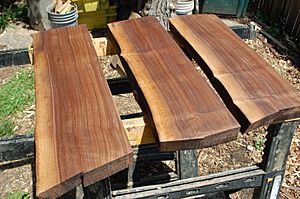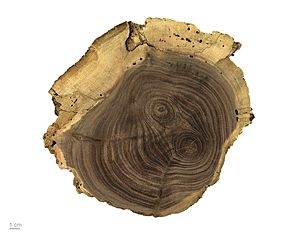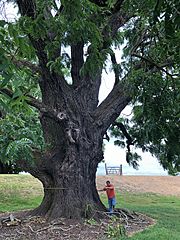Black walnut facts for kids
Quick facts for kids Eastern black walnut |
|
|---|---|
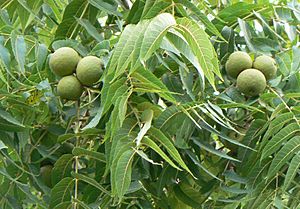 |
|
| Leaves and fruit | |
| Conservation status | |
| Scientific classification | |
| Genus: |
Juglans
|
| Species: |
nigra
|
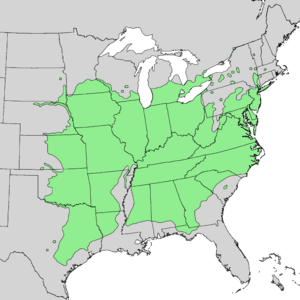 |
|
| Natural range | |
The Eastern black walnut (Juglans nigra) is a type of deciduous tree that belongs to the walnut family. It is originally from North America. This tree mostly grows near rivers and streams, from southern Ontario in Canada, west to South Dakota, and south to Georgia, northern Florida, and central Texas.
Black walnut trees are very important for business. Their wood is a beautiful deep brown and easy to work with. The nuts from these trees are also grown for their special and tasty flavor. People grow black walnuts for both their wood and their nuts. Many different types (called cultivars) have been created to get even better wood or nuts. However, black walnut trees can get a sickness called thousand cankers disease, which has caused many trees to die in some areas.
Black walnut trees are also known for being allelopathic. This means they release chemicals from their roots and other parts that can harm other plants. This helps the walnut tree grow better by reducing competition.
Contents
What the Black Walnut Tree Looks Like
- Smell: Most parts of the tree, like the leaves, stems, and the outer shell of the fruit, have a strong, spicy smell. The nut inside does not have this smell.
- Trunk: These trees can grow very tall, usually between 30 to 40 meters (about 100 to 130 feet). If they grow in a forest with other trees, their trunk will be tall and straight. If they grow in an open area, they will have a shorter trunk and a wide, spreading top (crown).
- Bark: The bark is usually grey-black and has deep grooves that form a diamond pattern.
- Twigs: The inside of the twigs (called the pith) is chambered, meaning it has small empty spaces, and is light brown.
- Buds: The buds are light-colored and covered in soft hairs. The buds at the end of a branch are oval-shaped and about 8 millimeters (0.3 inches) long.
- Leaves: The leaves are made up of many smaller leaflets (this is called compound). They are arranged one after another on the stem. Each leaf is about 30 to 60 centimeters (1 to 2 feet) long and usually has 15 to 23 leaflets. The biggest leaflets are in the middle, about 7 to 10 centimeters (3 to 4 inches) long. The leaflets have a rounded base and a pointed tip, with jagged edges. They are dark green and often hairy underneath.
- Leaf Scar: When a leaf falls off, it leaves a mark called a leaf scar. This scar has three clear dots and a small notch on the side that points towards the end of the branch.
- Flowers: Black walnut trees have both male and female flowers on the same tree (this is called monoecious). The male flowers hang down in long clusters called catkins, about 8 to 10 centimeters (3 to 4 inches) long. The female flowers grow in groups of two to five at the end of new branches.
- Fruit: The fruit ripens in summer or autumn. It is a round nut with a brownish-green, soft outer husk and a hard, bumpy brown nut inside. The whole fruit falls in October. The seed inside is quite small and very hard.
The tree does not produce the same amount of fruit every year. Some years have a lot of nuts, while others have fewer (this is called a mast year). Trees might start making fruit when they are 4 to 6 years old, but they need to be about 20 years old to produce a lot of nuts. A black walnut tree can live for about 130 years.
Like other trees in its group, such as oaks and hickories, the black walnut has separate male and female flowers. The wind carries pollen from the male flowers to the female flowers. Usually, the female flowers appear before the male flowers on the same tree. This makes it unlikely for a tree to pollinate itself. However, if there are no other trees nearby, a black walnut tree can still pollinate its own seeds.
For the seeds to grow best, they need to be kept cold and moist for 3 to 4 months. Young black walnut trees grow very quickly. They can grow about 90 centimeters (3 feet) in their first year and even more in their second year.
Black walnut trees do not grow leaves until the weather is warm enough. They lose their leaves in the fall when temperatures drop. This means the exact time they get and lose leaves changes depending on the region and the weather each year.
Black walnut trees have a strong taproot, which is a main root that grows straight down. This makes young trees strong, but also hard to move to a new spot.
Black walnuts are tougher against frost than English walnuts. They grow best in warm areas with rich, moist soil, but they can also grow in drier soils, just much slower. They like sandy, loamy, or silty soils because these soils hold a lot of water.
Black walnut trees look similar to butternut trees (Juglans cinerea). Their leaves are alike, and they grow in many of the same places. However, their fruits are very different: black walnuts are round, while butternuts are more oval. If there is no fruit, you can tell them apart by their leaf scars. Butternut leaf scars have a flat top edge with a fuzzy ridge above it. Black walnut leaf scars are indented and do not have a fuzzy ridge.
How Black Walnuts Live in Nature
Black walnut is often a pioneer species. This means it is one of the first trees to grow in new or disturbed areas, like along roadsides, in fields, or at the edge of forests in the eastern US. It can grow in thick forests, but it needs full sunlight to grow best and produce many nuts.
The black walnut tree grows across most of the eastern US. It is not found in the southern coastal areas or the Mississippi Valley. It also does not grow in the far northern parts of the eastern US, where the warm season is too short for its nuts to grow. Its range goes west to the eastern Great Plains, where it becomes too dry for the tree to survive.
Black walnut is one of the most common trees in the eastern US, especially in the Northeast. Its numbers are actually growing because other tree species have been affected by diseases and pests. These include problems like emerald ash borer and Dutch elm disease. When other trees are cut down or die, black walnuts can spread easily. This is also helped by their fast growth, the chemicals they release (allelopathy), and their seeds being spread by animals.
The nuts are a food source for many small animals, especially eastern fox squirrels, making up a good part of their diet. Birds also eat the nuts. White-tailed deer eat the leaves, but they are not their favorite food. Squirrels help the black walnut trees by burying their seeds. If the squirrels do not dig up all the buried seeds, those seeds can grow into new trees.
Sometimes, where the Eastern black walnut grows near the Texas black walnut (J. microcarpa), the two types of trees can mix and create new trees that have features of both. However, Eastern black walnuts and butternut trees, even though they often grow in the same areas, do not naturally mix.
The roots of black walnut trees often form special partnerships with tiny fungi called endomycorrhiza. These fungi can help the tree grow better.
Black walnut trees often grow alongside other trees like yellow-poplar, white ash, black cherry, basswood, American beech, sugar maple, oaks, and hickories. In drier areas, black walnuts might only grow near rivers and streams. There, they might grow with American elm, common hackberry, green ash, and boxelder.
Growing Black Walnuts
Planting
Even though black walnuts are native to the central and eastern United States, they were brought to Europe in 1629 and are also grown in Hawaii. People grow them in these places and in North America for their valuable wood. Black walnut trees can be planted to produce wood, nuts, or both. Special types of trees that are good for timber were developed by Purdue University in the 1990s.
You can buy nut-producing trees that have been grafted (where a part of one tree is joined to another). Some good types to consider are Thomas, Neel #1, and Sparrow.
When you plant black walnuts, you need to think about how they will be pollinated. Black walnut trees usually produce pollen first, and then female flowers, or vice versa. So, you should plant different types together. For example, a type that produces pollen early should be planted with types that produce female flowers early. This way, all the trees can get pollinated. Cranz, Thomas, and Neel #1 work well together for pollination.
Sometimes, black walnuts are planted to help fix land that has been mined. When young trees are growing, it is very important to control weeds around them. Weeds can slow down the growth of young trees a lot.
For Decoration
The black walnut tree is also grown as a beautiful tree in parks and big gardens. It can grow to be 30 meters (about 100 feet) tall and 20 meters (about 65 feet) wide. It has even won an award for being a great garden plant from the Royal Horticultural Society.
Uses of Black Walnuts
As Food
Black walnut nuts are safe to eat and are sold commercially in the United States. About 65% of the wild nuts harvested each year come from Missouri. The biggest factory for processing them is in Stockton, Missouri. The nutmeats have a strong, special flavor and a nice crunch that makes them a great ingredient in food.
People often use black walnuts in ice cream, baked goods, and candies. They are popular in traditional treats like cakes, cookies, fudge, and pies, especially around the fall holidays. Because they are healthy, black walnuts are also used in other dishes like salads, with fish, pork, chicken, vegetables, and pasta.
In the spring, if you tap the tree, it produces a sweet sap. You can drink this sap or boil it down to make syrup or sugar, much like sugar maple sap.
How to Process Nuts by Hand
Getting the nut out of a black walnut fruit is hard. The outer husk is thick and tough, and the hard shell inside is tightly held by ridges. A common way to remove the husk is to roll the nut under your foot on a hard surface like a driveway. Factories use a car tire spinning against a metal screen. Some people drill a nut-sized hole in a thick piece of wood and then hit the nut through the hole with a hammer. The nut goes through, and the husk stays behind.
The shell itself is thicker than an English walnut shell. There are also thick walls inside the shell that tightly surround the nutmeat. Black walnuts are too tough and big for a regular nutcracker. If you just smash them with a rock, the nutmeat often gets broken into tiny pieces and mixed with shell. Because of this, many special tools have been made to crack black walnuts at home, using clamps or levers.
Even though the flavor of the black walnut kernel is highly valued, it is hard to prepare. This might be why English walnuts are more popular and easier to find.
Nutrition
Black walnut kernels are healthy! For every 100 grams, they have about 619 calories. They are mostly fat (59%), protein (24%), and some carbohydrates (10%). They are packed with important dietary minerals like manganese and phosphorus, and B vitamins like B6. They also have some vitamin E.
Dye
The outer husks of black walnuts contain natural chemicals like juglone and tannins. These chemicals can stain cars, sidewalks, and your hands if you try to shell them!
Early American settlers used the brownish-black dye from walnuts to color hair. The liquid from the inner husk gets darker over time as the outer skin changes from light green to black. Today, people still use extracts from the soft outer part of the fruit as a natural dye for crafts.
The tannins in walnuts also help the dye stick to things. They can even be used to make dark ink or wood stain.
Industrial Uses
Walnut shells are very hard. Because of this, they are often used as an abrasive, like in sandblasting, when a medium-hard grit is needed. The hard black walnut shell is also used in other ways, such as for cleaning things, as a filter in smokestack scrubbers, for cleaning jet engines, in cosmetics, and in oil well drilling and water filtration.
Wood
Black walnut wood is highly valued for its dark color, straight grain, and strong inner wood. It is heavy, strong, and can handle shocks, but it is also easy to split and work with. Along with cedar, chestnut, and black locust, black walnut is one of the most durable hardwoods in the US. The wood can be dried in a special oven (kiln-dried) and keeps its shape well, which makes it great for woodworking.
Historically, walnut wood has been used for gun stocks, furniture, flooring, boat paddles, coffins, and many other wood products. Because it is so valuable, forest officers sometimes have to track down people who illegally cut down walnut trees. In 2004, DNA testing was used to solve a case where a 16-meter (55-foot) tree worth US$2,500 was stolen. Black walnut wood is less dense than oak.
Pests of Black Walnuts
Maggots (larvae of certain flies) often live in the husk of the walnut. For people harvesting nuts at home, these maggots are more of a bother than a serious problem because they stay in the husk and do not harm the nut inside. However, they make the husk hard to remove and look unpleasant. For commercial growers, maggots can be a big problem, so they often use chemicals to protect their crops. You can also remove and throw away nuts that have maggots.
The walnut weevil is a small beetle, about 5 millimeters (0.2 inches) long. The adult weevil sucks plant juices. It lays its eggs in the fruits in spring and summer. Many nuts are lost because the larvae (young weevils) burrow through the nut shell.
Black walnut trees can also get a disease called European canker. This infection spreads slowly, but eventually, infected trees will die.
The walnut caterpillar and fall webworm are two of the most serious insect pests. They commonly eat the leaves in midsummer and continue into autumn.
Codling moth larvae eat walnut kernels, as well as apple and pear seeds.
Other insects that suck juices from leaves include types of aphids and plant lice. They can leave a sticky substance called "honey-dew" on the leaves, which can turn black and stop the plant from making food. The walnut lace bug also causes damage by sucking sap from the underside of the leaves.
A serious disease called thousand cankers disease has been threatening black walnut trees in several western states. It has recently been found in Tennessee and could cause a lot of damage to the species in the eastern United States. This disease is spread by a tiny beetle called the walnut twig beetle. A fungus spreads into the wood where the beetles make their tunnels. The fungus causes sores (cankers) that stop nutrients from moving through the tree, leading to branches dying and eventually the whole tree dying.
Allelopathy: The Walnut's Secret Weapon
Black walnut trees are allelopathic. This means they release chemicals into their surroundings that harm other plants. Many plants do this, but walnuts are especially famous for it. People have noticed walnuts harming other plants for a very long time.
Like other walnut trees, the roots, inner bark, nut husks, and leaves contain a chemical called hydrojuglone. When this chemical touches air or soil, it changes into juglone. Juglone is active and can stop some plants from breathing properly. Juglone does not dissolve well in water, so it does not move far in the soil. It stays most concentrated right under the tree. Even after a tree is removed, the soil where its roots were will still have juglone for several years as the roots decay. Soil that drains well and has good air flow will have healthy microbes that help break down the juglone.
Signs that a plant has been poisoned by juglone include its leaves turning yellow and wilting. Some plants are very sensitive to juglone. Apples, tomatoes, pines, and birch trees can be poisoned by juglone, so they should not be planted close to a black walnut tree.
Black Walnuts and Horses
Horses can get a hoof problem called laminitis if they are exposed to black walnut wood in their bedding.
Biggest Black Walnut Trees
The largest black walnut tree in the US is on Sauvie Island, Oregon. It is 2.6 meters (8 feet 7 inches) wide at chest height and 34 meters (112 feet) tall. Its branches spread out 44 meters (144 feet) wide.
The tallest black walnut tree in Europe is in Woluwe Park in Brussels, Belgium. It is 3.50 meters (11 feet 6 inches) around and exactly 33.60 meters (110 feet) tall. It was planted around 1850.
The largest black walnut tree in Europe is in the Castle Park in Sereď, Slovakia. It is 6.30 meters (20 feet 8 inches) around and 25 meters (82 feet) tall. It is estimated to be 300 years old.
Images for kids
See also
 In Spanish: Nogal negro americano para niños
In Spanish: Nogal negro americano para niños



